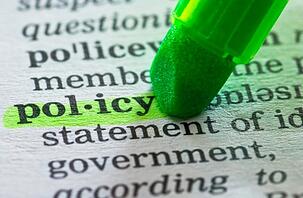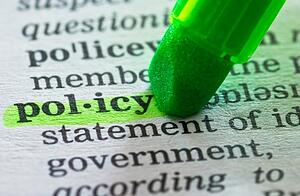Even if your organization is shy of embracing social media for its business benefits, the fact remains that it is not a medium that can be ignored. Whether endorsed by the company or not, your employees, job candidates, customers, prospects, shareholders and other key audiences are likely active online, and without establishing some kind of social media guidelines for their behavior, you run the risk of damaging your company's reputation.
A Social Media Policy, at its core, is simply a set of guidelines to share with employees that provides clear rules and regulations for online activity — both during and outside of work hours.
However, with social media only recently becoming a force to consider in the workplace, many people (including those at the executive level), are at a loss for how to approach this new form of communication. How can you go about setting parameters that will encourage employees to be themselves, and protect their own and the company’s reputations, without stifling personal freedoms?
Following is a four-step plan for developing your company’s Social Media Policy.

Step 1: Find your champions.
Establish a committee, or team of internal stakeholders, that will be involved in the development and approval of the company’s social media policy. Ideally this group will embrace the business benefits of social media, and include: someone at the executive level, representatives from several departments within the organization, and at least one social media active.
Step 2: Do your research.
Find out what people are saying about your company online by running Google, Facebook and Twitter searches for your company name, popular products and executives.
Review the company’s current social media participation, both at the individual and corporate levels. Send internal surveys to determine who is active online, on what sites and to what extent. See where your organization lies on Forrester's Social Technographics Ladder using their Social Technology Profile Tool.
Look into blog and forum comments from active personnel, as well as Twitter, Facebook and LinkedIn profiles. Determine the online influence of employees through Grader tools from HubSpot.
While scouring the net, did you come across any red flags? If you see negative comments (either from internal or external parties) about your company, or identify any inappropriate employee behavior, take note of them to ensure that such instances are addressed in your policy.
Step 3: Take advantage of existing resources.
It’s quite likely that you already have existing policies in place regarding employee behavior. So, why start from scratch? Just because the platform is different doesn’t mean that you’re telling employees anything new in regard to what is considered acceptable or unacceptable activity and information sharing. For example:
- Consider language in existing employee handbooks specific to professional behavior.
- Consider any corporate communications and/or legal policies or procedures related to communications made by company representatives and employees.
- Evaluate any internal communications to date specifically related to social media participation, either on an individual, departmental or corporate level.
- Review any existing internal documentation and/or strategy related to monitoring social media activity.
Step 4: Develop your Social Media Policy.
Armed with all the information you need, now it’s time for the committee to sit down and develop your organization’s social media guidelines. A few elements to consider:
Start with an introduction to social media: What it is and why the company is addressing it.
State the goal of the policy, and how it integrates with those that already exist.
Lay out 10-15 guidelines for employees to follow in their online behavior. A best practice is to focus on what is appropriate rather than what is not, to keep the tone positive. Specific topics to cover may include:
- Authentic representation of brand and self: The importance of using real names, and the lack of true anonymity on the Web.
- Disclosure, confidentiality and privacy, such as: guidelines for sharing company information with the public, who has the authority to comment on behalf of the company, and when it is necessary to disclose affiliations with the company and/or clients.
- Having a purpose in online communications, and bringing value to the community.
- Policies for usage and productivity during business hours.
- Professionalism: Taking ownership of your words and actions, and respecting copyrights.
- How government or industry regulations apply to online conversations.
- How to address potential challenges before they occur, such as “friending” colleagues, superiors and subordinates.
Address plans for monitoring and enforcement:
- Determine who is responsible for monitoring employees’ online behavior, and what this entails.
- Clearly state the ramifications of misuse, and how policies will be upheld.
Also, consider sharing an appendix of resources with employees that may help them be more productive in their use of online media. For example: introductions to Netvibes or Google Reader, directions for setting up Google Alerts, or details on Facebook privacy settings.
Does your organization have a formal Social Media Policy? What are the key elements it includes?
Laurel Miltner is a consultant at PR 20/20, a Cleveland-based inbound marketing agency and PR firm. Follow Laurel on Twitter @laurelmackenzie.
Subscribe to receive the PR 20/20 blog by email or RSS feed.
Additional (External) Resources:
%20Logo_BlueOrange_Trademark.png?width=800&height=269&name=Ready%20North%20(RN)%20Logo_BlueOrange_Trademark.png)




.jpg?width=300&name=Services%20Hub%203%20(3).jpg)


COMMENTS